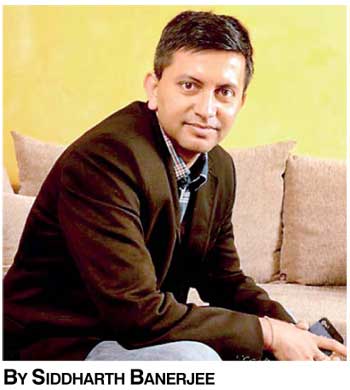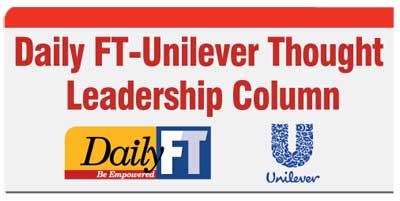Sunday Dec 14, 2025
Sunday Dec 14, 2025
Tuesday, 29 September 2015 00:05 - - {{hitsCtrl.values.hits}}
By Siddharth Banerjee
The marketing landscape across the world is currently in a period of great change with digital media, and social media in particular, being a huge disruptor; much like the printing press was in its time. In this changing context, marketers need to urgently understand that the proliferation of new media channels and changes in consumer behaviour with respect to brands, has made it necessary for brands to re-evaluate how they engage with their consumers.
Today, 3.1 out of 7.3 billion people in the world are connected to the internet. This number is increasing by 7.6% each year, while the population is only increasing by 2.5% each year. The phrase ‘what a small world’ holds truer than ever today, as we become  increasingly more connected. This greater connection, greater access to information, people and services, has resulted in a highly informed and networked consumer, thus creating a fundamental shift in the way brands communicate. As Scott Cook, co-founder, Intuit says, “A brand is no longer what we tell the consumer it is – it is what consumers tell each other it is.”
increasingly more connected. This greater connection, greater access to information, people and services, has resulted in a highly informed and networked consumer, thus creating a fundamental shift in the way brands communicate. As Scott Cook, co-founder, Intuit says, “A brand is no longer what we tell the consumer it is – it is what consumers tell each other it is.”
Here, in Sri Lanka, one observes similar industry and consumer trends. Our internet penetration is at 24%, higher than India’s 16%, and is growing at a rate of 22% each year. This growth is supplemented with strong infrastructure, offering 4G and 4G LTE connectivity, and affordable smartphones available in the market.
It has allowed for 2.8 million active social media users in the country, with 80% of these users accessing social media through their mobile phones, and the user base growing at 40% each year. 57% of web traffic in Sri Lanka was viewed on mobile phones while the web traffic on PCs and laptops is decreasing by 2% each year. In summary, there is a substantial digital access available to consumers to seek information and solutions.
Also, noteworthy is the rise of social media platforms which have ensured that people can engage with brands more than ever before, with real-time dialogue possible rather than one-way communication. But this unique opportunity also means brands need to be understand deeply the manner in which they engage with consumers, since consumers have moved from being absorbers to being publishers and influencers. Newspapers, TV and Radio are no longer the only access routes to information. With 21 million cellphone connections in the nation, (almost) everybody has a mobile phone!
However, in this new age of choice, this is not to say that traditional media is dead or not relevant. In Sri Lanka, it still continues to be the best way to reach a wide audience. What is important for marketers is that we couple the growing power of digital media with our relevant traditional media channels. For example, consumers regularly cite online reviews and word-of-mouth (WOM) amongst the most trusted sources of information.
It is the precisely the unique targeting capabilities of the new digital media channels, the always-on nature of the messaging and the rich consumer data they can potentially provide, which allow brands to tailor their messaging and share it with specific target audiences at different stages in the purchase funnel.
Brands like Oreo (in the US Super Bowl) and Coca Cola (with over 87 million personalised videos sent out to Facebook users for their  ‘America is Beautiful’ campaign) have utilised new media with traditional channels with great impact, and provide rich learning for us in this area.
‘America is Beautiful’ campaign) have utilised new media with traditional channels with great impact, and provide rich learning for us in this area.
At Unilever Sri Lanka, two recent campaigns highlight the immense possibilities of digital media and our ability to leverage it to engage our consumers with our much-loved brands.
The ‘Lighting Up My Nation’ campaign for Sunlight utilised unique consumer insights to leverage the 135% penetration of mobile phones and 15% penetration of smart phones. This Vesak campaign, where we partnered with Dialog, invited people across the nation, to light digital lamps at the Dalada Maligawa Temple through a simple missed call mechanic. Within six days, we received over 1.1 million missed calls (that is about 6% of the nation’s population) and a huge stream of consumer feedback and brand love. No wonder then, Sunlight is one of the fastest growing Laundry brands globally for Unilever with substantial gains in brand equity scores and market share.
Similarly, with the Fair & Lovely (FAL) Max ‘Unbuyable Bike’ campaign, we worked on the insight that a lot of young men aspire to be the ‘alpha’ males and hence we conceived the Max Pora concept. This resulted in a unique consumer activation which gave away seven powerful all American motorbikes (choppers to be precise) with seven distinct themes.
Whilst the campaign had its traditional components, it primarily adopted an ‘always-on’, content-rich and a WOM-based digital strategy combining a micro-site (maxpora.lk) with extensive use of social media and significant SEM spends. As the campaign progressed, FAL Max connected with approximately 1.5 million males online with exciting content that mattered, culminating in a 180% sales growth in Q2’15 – a period of sales which has been the highest historic results for the brand.
Therefore, while consumers are able to publish their own opinions and influence people, brands should also be able to focus their messages and communicate directly to their target audiences. The digital age brings with it an increased level of sophistication in marketing with a proliferation of comprehensive data tools that allow marketers to obtain a better understanding of their consumers and so effectively, engage them.
Also, with the rise of mobile web traffic and social media use, marketers must create customised content specifically for these devices and utilise the convenience, ubiquity and mobility of these devices in our campaigns, making digital media a priority communication channel for our brands. Hence, the time is already here where marketers need to re-skill themselves, acquire fluency in the latest media channels and analytics tools and thus, become keen apprentices of the digital world. With a hat-tip to Aldus Huxley, welcome marketers to the “Brave New World”…
(Siddharth Banerjee is an FMCG professional with 15 years of international experience and is currently the Country Marketing Director for Unilever Sri Lanka.)